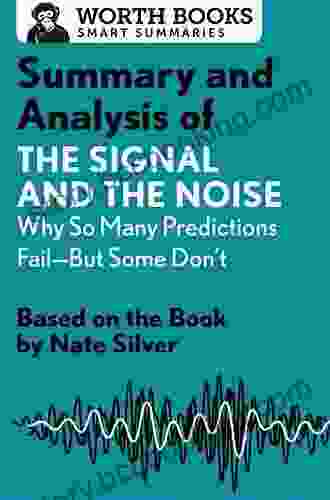Why So Many Predictions Fail But Some Don't: Unlocking the Secrets of Accurate Forecasting

Forecasting has emerged as a critical aspect of modern decision-making. From business strategies to scientific advancements, accurate predictions hold the power to guide our actions and shape our future. Yet, despite the widespread use of forecasting techniques, many predictions falter, leaving us confounded and unsure of why they failed.
4.5 out of 5
| Language | : | English |
| File size | : | 9012 KB |
| Text-to-Speech | : | Enabled |
| Screen Reader | : | Supported |
| Enhanced typesetting | : | Enabled |
| Word Wise | : | Enabled |
| Print length | : | 546 pages |
In this comprehensive article, we delve into the fascinating realm of forecasting, exploring the reasons behind the failure of numerous predictions and unraveling the secrets behind those that succeed. By understanding the factors influencing forecast accuracy and the techniques employed by successful forecasters, we can improve our own forecasting abilities and make more informed decisions.
Why Do Predictions Fail?
Numerous factors can contribute to the failure of predictions, including:
- Uncertain and Complex Systems: Predicting the behavior of complex systems, such as the economy or the weather, is inherently challenging due to the presence of numerous variables and the interconnectedness of different elements.
- Cognitive Biases: Forecasters are susceptible to cognitive biases, such as confirmation bias and anchoring, which can lead to inaccurate predictions by distorting their perceptions and judgments.
- Lack of Data and Analysis: Predictions based on insufficient data or inadequate analysis are more likely to be flawed. Failing to consider relevant historical data or using inappropriate forecasting methods can result in erroneous outcomes.
- Unforeseen Events: Unpredictable events, such as natural disasters or economic crises, can disrupt forecasts, rendering them inaccurate. These events are often difficult to foresee and can significantly impact outcomes.
Anatomy of Successful Predictions
While many predictions fail, some succeed with remarkable accuracy. These successful predictions often share common characteristics, including:
- Robust Methodology: Accurate predictions rely on well-defined and validated forecasting methodologies. These methodologies consider relevant variables, historical data, and appropriate statistical techniques to produce reliable forecasts.
- Rigorous Analysis: Successful forecasters engage in rigorous data analysis to identify patterns, trends, and relationships that inform their predictions. They employ various statistical and modeling techniques to extract insights from data.
- Domain Expertise: Forecasters who possess deep knowledge and understanding of the specific domain or field they are predicting in can make more accurate forecasts. Their expertise enables them to make informed judgments and interpret data more effectively.
- Calibration and Refinement: Successful predictions are often calibrated and refined over time. Forecasters compare their predictions to actual outcomes and make adjustments to their methodologies and assumptions based on the feedback they receive.
Improving Forecast Accuracy
To improve the accuracy of our predictions, we can adopt the following strategies:
- Understand the Limitations: Recognize the inherent limitations of forecasting and avoid making predictions beyond the scope of reliable data and analysis.
- Use Multiple Methods: Employing a combination of forecasting methods can help mitigate the weaknesses of individual techniques and provide more robust predictions.
- Incorporate Uncertainty: Acknowledge and communicate the level of uncertainty associated with predictions. Avoid presenting predictions as absolute truths and instead indicate the range of possible outcomes.
- Monitor and Evaluate: Regularly compare predictions with actual outcomes to identify areas for improvement. This feedback loop allows forecasters to refine their methodologies and enhance accuracy over time.
Delving into the realm of prediction, we have explored the reasons why many predictions fail and the strategies employed by those that succeed. Accurate forecasting is a valuable skill that empowers us to make informed decisions, plan for the future, and mitigate risks. By understanding the factors influencing forecast accuracy and adopting the techniques used by successful forecasters, we can improve our own forecasting abilities and navigate an uncertain world with greater confidence.
4.5 out of 5
| Language | : | English |
| File size | : | 9012 KB |
| Text-to-Speech | : | Enabled |
| Screen Reader | : | Supported |
| Enhanced typesetting | : | Enabled |
| Word Wise | : | Enabled |
| Print length | : | 546 pages |
Do you want to contribute by writing guest posts on this blog?
Please contact us and send us a resume of previous articles that you have written.
 Book
Book Novel
Novel Page
Page Chapter
Chapter Text
Text Story
Story Genre
Genre Reader
Reader Library
Library Paperback
Paperback E-book
E-book Magazine
Magazine Newspaper
Newspaper Paragraph
Paragraph Sentence
Sentence Bookmark
Bookmark Shelf
Shelf Glossary
Glossary Bibliography
Bibliography Foreword
Foreword Preface
Preface Synopsis
Synopsis Annotation
Annotation Footnote
Footnote Manuscript
Manuscript Scroll
Scroll Codex
Codex Tome
Tome Bestseller
Bestseller Classics
Classics Library card
Library card Narrative
Narrative Biography
Biography Autobiography
Autobiography Memoir
Memoir Reference
Reference Encyclopedia
Encyclopedia Major T Benton
Major T Benton List Series
List Series Nachole Johnson
Nachole Johnson Sue Elvis
Sue Elvis Lujain Al Iman
Lujain Al Iman Mara Krechevsky
Mara Krechevsky Keely Hutton
Keely Hutton Matthew Olshan
Matthew Olshan Stephen Coles
Stephen Coles Manjit Kumar
Manjit Kumar Lucinda Berry
Lucinda Berry Margaret Rogerson
Margaret Rogerson Michelle Newhart
Michelle Newhart Ray Bella
Ray Bella Lynn A Higgins
Lynn A Higgins Holly Hook
Holly Hook Malcolm Russell
Malcolm Russell Martin Jarvis
Martin Jarvis Orji Onyebuchi
Orji Onyebuchi Ruby Ann Phillips
Ruby Ann Phillips
Light bulbAdvertise smarter! Our strategic ad space ensures maximum exposure. Reserve your spot today!

 Alfred RossLiterary Treasury for the Advancement of the Arts in Worship: A Comprehensive...
Alfred RossLiterary Treasury for the Advancement of the Arts in Worship: A Comprehensive...
 Edward BellUnwrap the Magic of Christmas with "The Brick on the Stick and the Christmas...
Edward BellUnwrap the Magic of Christmas with "The Brick on the Stick and the Christmas...
 Clarence BrooksUnlock the Best of Canada: Your Essential Travel Companion from Lonely Planet
Clarence BrooksUnlock the Best of Canada: Your Essential Travel Companion from Lonely Planet Terry PratchettFollow ·4.2k
Terry PratchettFollow ·4.2k Robert Louis StevensonFollow ·12.7k
Robert Louis StevensonFollow ·12.7k Jon ReedFollow ·3.8k
Jon ReedFollow ·3.8k Hugh ReedFollow ·19.9k
Hugh ReedFollow ·19.9k Wayne CarterFollow ·16.3k
Wayne CarterFollow ·16.3k Ed CooperFollow ·5.6k
Ed CooperFollow ·5.6k Richard SimmonsFollow ·11.4k
Richard SimmonsFollow ·11.4k Carter HayesFollow ·10.2k
Carter HayesFollow ·10.2k

 Truman Capote
Truman CapoteShort, Skinny Mark Tatulli: The Ultimate Guide to a...
Are you tired of being...

 Robert Heinlein
Robert HeinleinEmbark on an Unforgettable Cycling Adventure: The Classic...
Explore the Timeless...

 Bryce Foster
Bryce FosterMisty Twilight: Marguerite Henry's Enduring Masterpiece
A Literary Legacy that...

 Anton Chekhov
Anton ChekhovUnleash the Explosive Power of DC Comics Bombshells 2024...
Prepare yourself for an...

 Juan Butler
Juan ButlerUnleash the Thrill: Discover 'Know Your Rider' by...
Prepare yourself for an...
4.5 out of 5
| Language | : | English |
| File size | : | 9012 KB |
| Text-to-Speech | : | Enabled |
| Screen Reader | : | Supported |
| Enhanced typesetting | : | Enabled |
| Word Wise | : | Enabled |
| Print length | : | 546 pages |








